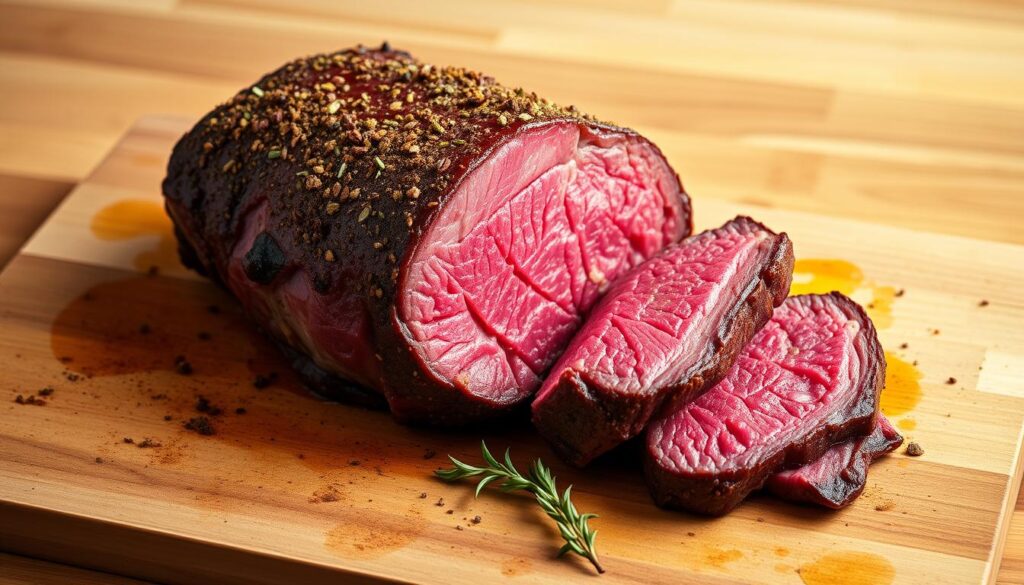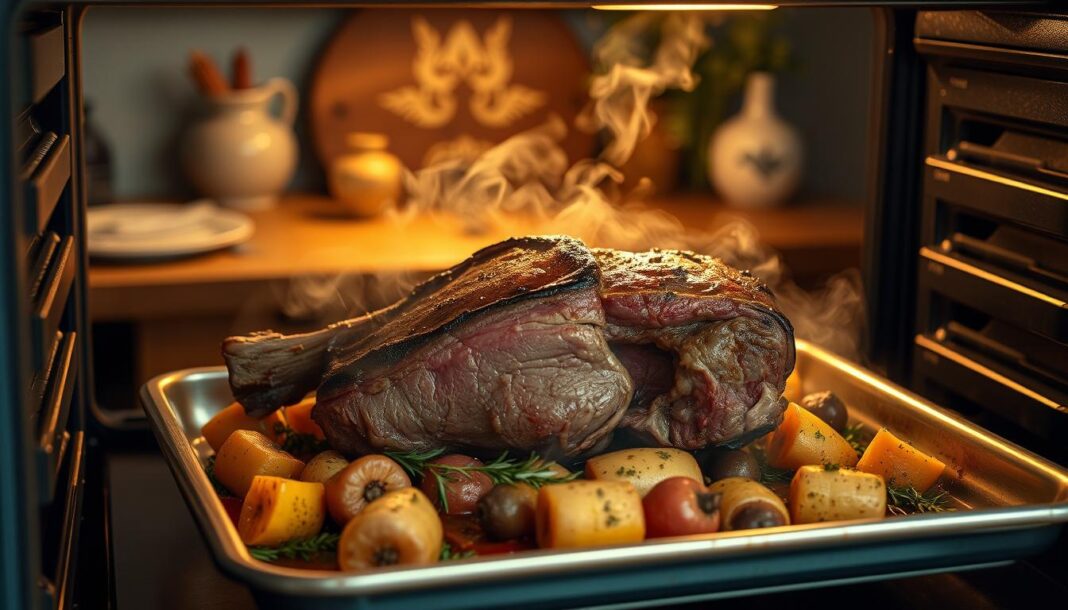Dispelling the myths surrounding venison, we find that cooking deer meat can be a rewarding experience, yielding juicy and flavorful results. Contrary to popular belief, wild game like venison isn’t inherently tough or gamey.
Understanding the unique properties of venison is crucial for successful oven preparation. As a lean meat, it requires specific techniques to achieve tender, flavorful outcomes. Our comprehensive guide will walk you through each step, from selecting the right cuts to determining ideal cooking times and temperatures in the oven.
By mastering these techniques, you’ll be able to transform deer meat into restaurant-quality dishes, leveraging the natural flavors of this wild game. Whether you’re a seasoned chef or a home cook, our guide empowers you to achieve culinary success with venison.
Understanding Venison: What Makes Deer Meat Special
Unlike conventional meats, venison offers a leaner alternative that requires specific cooking techniques to bring out its best qualities. We explore what makes deer meat unique and how to capitalize on its distinct characteristics.
The Lean Nature of Venison
Venison is exceptionally lean, containing significantly less fat than beef. This leanness necessitates different cooking approaches to prevent the meat from becoming tough.
Debunking the “Gamey” Flavor Myth
The misconception of deer meat having an overpowering “gamey” flavor often stems from improper handling or cooking techniques. In reality, venison has a rich, earthy flavor profile, thanks to the deer’s natural diet.
Health Benefits of Cooking with Deer Meat
Venison is not only flavorful but also nutritious, offering higher protein content and less saturated fat and cholesterol compared to beef. It’s an excellent source of essential nutrients like iron, zinc, and B vitamins.
Preparing Your Deer Meat for Oven Cooking
Preparing your deer meat for oven cooking is a crucial step that can make all the difference in the final dish. It involves several key processes that ensure your venison is tender, flavorful, and cooked to perfection.
Choosing the Best Venison Cuts for Roasting
Selecting the right cut of venison is the first step in preparing a delicious oven-roasted deer meat. We recommend choosing cuts based on your desired outcome—tenderloin and backstrap excel for roasting due to their tenderness, while tougher cuts like shoulder benefit from slower cooking methods.
Properly Thawing Frozen Venison
Proper thawing is critical for maintaining venison quality. Always thaw meat gradually in the refrigerator rather than at room temperature to maintain texture and prevent bacterial growth.
Marinating Techniques to Enhance Tenderness
Marinating venison serves dual purposes: enhancing flavor while breaking down muscle fibers. Acidic ingredients like Worcestershire sauce, vinegar, or citrus juice are particularly effective tenderizing agents. For steaks, we suggest marinating for at least 4-8 hours, and up to 24 hours for larger venison roast cuts.
| Venison Cut | Marinating Time | Recommended Seasoning |
|---|---|---|
| Venison Steaks | 4-8 hours | Salt, Pepper, Garlic |
| Venison Roast | Up to 24 hours | Rosemary, Thyme, Juniper Berries |
Essential Seasonings for Flavorful Deer Meat
Basic Salt and Pepper Approach
For those new to cooking venison, starting with a basic salt and pepper approach allows you to appreciate the meat’s inherent flavors before experimenting with more complex seasoning blends.
Herb and Spice Combinations
More adventurous cooks might try herb and spice combinations that include garlic, onion powder, paprika, and bay leaves for a more complex flavor profile that enhances the venison’s character.

How to Cook Deer Meat in the Oven
Achieving perfect venison in the oven requires attention to detail and the right techniques. We will guide you through the process, ensuring that your deer meat is cooked to perfection every time.
Searing Your Venison Before Oven Cooking
We begin by searing the venison in a hot cast iron skillet. This crucial step creates a flavorful crust that seals in juices before transferring to the oven. To sear, drizzle a little olive oil into the skillet and let it get really hot. Once the oil starts to smoke slightly, lay your steaks on the pan and hear them sizzle. Give a nice sear on one side for about 20 seconds, then flip it over.
Setting the Right Oven Temperature
For most venison cuts, setting your oven to 350 degrees Fahrenheit (175°C) provides the ideal temperature balance. This allows the meat to cook through without drying out. Preheat your oven to this temperature to ensure even cooking.
Determining Cooking Time Based on Cut Size
Cooking time varies significantly based on the size of the venison cut. Smaller steaks may require only 8-10 minutes in the oven, while a larger venison roast might need 15-20 minutes per pound to reach perfect doneness.
Using a Meat Thermometer for Perfect Doneness
Using a meat thermometer is crucial for cooking venison to the right doneness. We recommend removing the meat from the oven when it reaches 120-125°F for rare or 130-135°F for medium-rare.
Ideal Internal Temperatures
For rare venison, aim for an internal temperature of 120-125°F. For medium-rare, target 130-135°F. Avoid temperatures above 140°F, as this can make the lean meat tough.
Visual Cues for Doneness
Besides using a thermometer, visual cues can help determine doneness. A slight firmness to the touch while maintaining some give is a good indicator. For steaks, a gentle flop when lifted with tongs indicates perfect medium-rare texture.
| Doneness | Internal Temperature (°F) | Visual Cue |
|---|---|---|
| Rare | 120-125 | Firm but yielding to touch |
| Medium-Rare | 130-135 | Gentle flop when lifted |
Adding Butter and Moisture During Cooking
Adding butter during the final cooking stages introduces fat that venison naturally lacks, enhancing both flavor and moisture. Simply place a pat of butter on top of the hot meat and allow it to melt into the surface.
The Critical Resting Period
The resting period of 5-10 minutes after removing venison from the oven is critical. This allows juices to redistribute back through the meat fibers rather than escaping when cut. For larger roasts, tent loosely with foil during resting to maintain temperature.
Serving Your Oven-Roasted Venison
Serving venison can elevate any meal, and with the right accompaniments, it’s truly special. We recommend slicing your venison roast against the grain into thin medallions to maximize tenderness. Traditional steakhouse sides complement venison beautifully; consider serving with roasted fingerling potatoes, grilled asparagus, or sautéed mushrooms.
Unlike beef, perfectly cooked venison needs minimal accompaniment. A simple pan sauce made from the cooking juices, a splash of red wine, and a pat of butter creates an elegant finish. The lean nature of venison pairs exceptionally well with acidic or fruit-based accompaniments like cranberry compote or a balsamic reduction.


